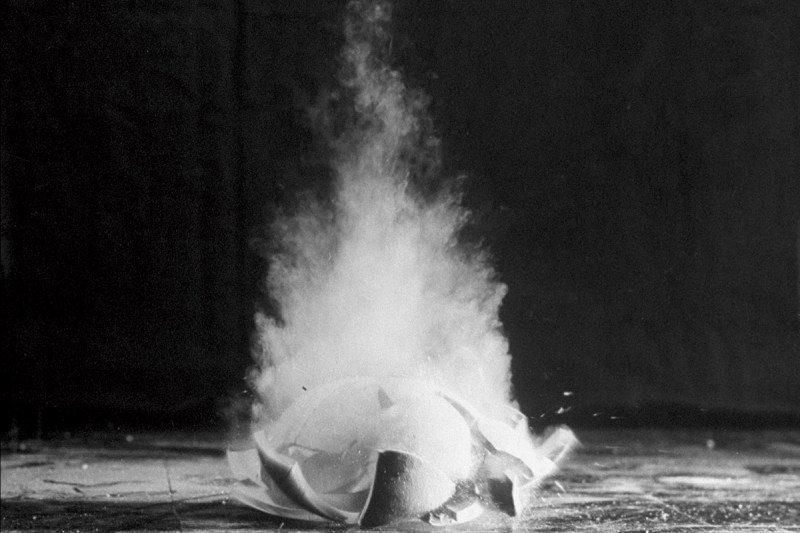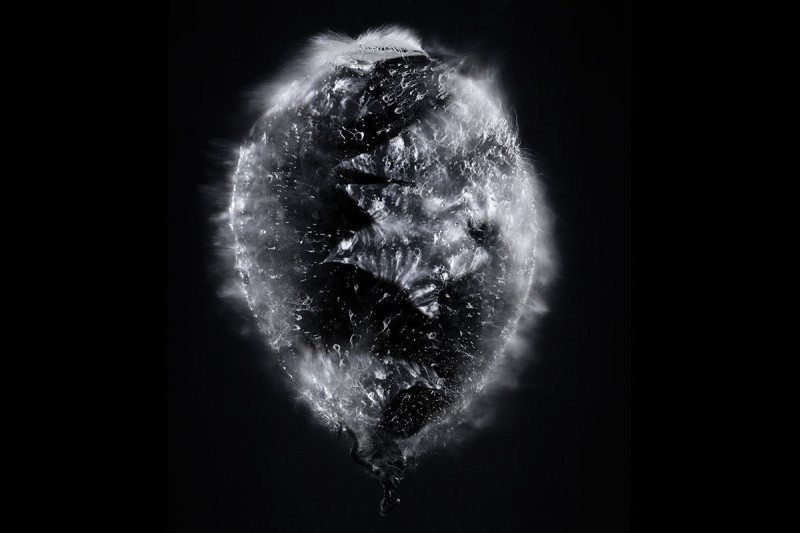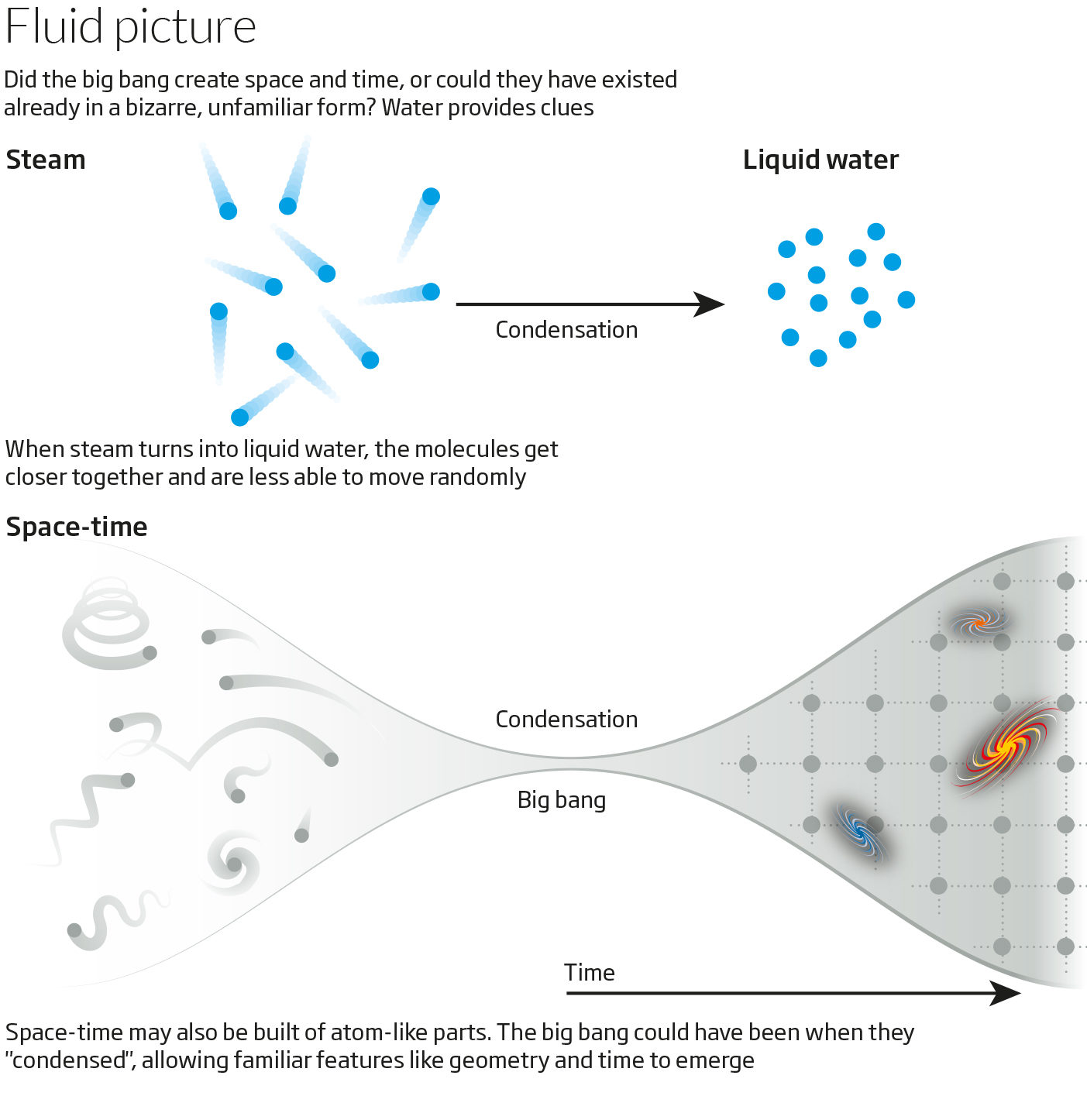We are told it was big, yet it was probably unimaginably small. We are told there was a bang, yet there was apparently no sound, and no space for anything to explode into. Some think it might have happened multiple times, so even its definite article is in doubt.
Although everyone has heard of the big bang, no one can say confidently what it was like. After all, recounting the beginning of time is about finding not just the right words, but the right physics - and ever since the big bang entered the popular lexicon, that physics has been murky.
Perhaps no longer, thanks to an unusual way of delving into our universe's backstory that has emerged over the past few years. In this view, the essence of space and time can exist beyond the confines of the cosmos, but in a state of roiling chaos we would not recognise. The big bang is not a hard-and-fast beginning, but a moment of profound transformation - one quite different from anything most of us could have imagined.
Though often misattributed to the US astronomer Edwin Hubble, the basic idea of the big bang dates back to the Belgian priest and astronomer Georges Lemaître, who observed in the late 1920s that the universe is expanding. Extrapolating backwards, Lemaître imagined a "primeval atom" that ballooned into everything we see today.
What was this primeval atom, and where did it come from? Such questions can't be posed without some trepidation. Stephen Hawking famously argued that asking what came before the big bang is like asking what is north of the north pole. Since time itself was created at that moment, he reckoned, the question of a prior origin is meaningless.
That hasn't stopped physicists from trying to pick it apart. Lemaître himself floated the possibility of a phoenix universe, whose expansion slows, reverses and ultimately collapses into a new primeval atom - before bursting outwards into life once again.
A more elaborate version of this cyclical story was proposed at the turn of this century by Paul Steinhardt at Princeton University, Neil Turok, then at the University of Cambridge, and others. In their ekpyrotic hypothesis - a name derived from an Ancient Greek word for a conflagration - an early speck of our universe drifted around in another dimension, eventually smashing into another universe, liberating untold energy and sparking explosive growth.
Wild as that may sound, some proposals get wilder. Take inflation, a widely supported theory that supposedly explains how the primeval atom blew up from something infinitesimal, before expanding at the more leisurely pace we see today. This growth spurt was instigated by a random fluctuation in a quantum field, and something similar could happen at any time and any place. That not only means that other universes could be invisibly branching off from ours, but also suggests our own universe could be one branch of an infinitely old multiverse.
Yet whether we invoke ekpyrotic collisions or infinite inflation, attempting to demystify the big bang as a moment that recurs throughout eternity doesn't get us any closer to describing exactly what happens in that key moment.
The big bang was born from our best theory of gravity, general relativity. Here space and time are unified as space-time, the invisible canvas of reality. Stars and planets deform space-time, and this warping creates the pull of gravity. We know from astronomical observations that space-time is expanding, and so according to general relativity it must once have been an infinitely tiny, infinitely dense point known as a singularity.
That's nice and neat as far as it goes. But it stops short of describing all the stuff within space-time - stuff that is governed by quantum theory. This most successful of theories deals with the small, yet finite: particles and chunks of energy. "Finite" is the operative word here. Rewind the quantum universe, and you see galaxies collapse and stars unborn, and atoms dissociate into their nuclei and attendant electrons. When space is very tight indeed, you see signs that all nature's forces, bar gravity, unify into just one. But that force still comes in chunks - and that is as far as quantum theory can take us. It can do incredibly small, but unlike space-time it can't diminish smoothly to zero.

In one popular theory, loop quantum gravity, these atoms of space are loops of nothingness defined by mathematics. There are other options too, but most focus on describing the atoms of space accurately in the assumption that a coherent quantum description of space-time, including the big bang, will then fall into place. Hu believes that's optimistic. "That last step is made out to be straightforward," he says. "It isn't."
Nebulous netherworld
For more than a decade, Hu has backed attempts to bridge that gulf. And it is out of this quest that a potentially satisfying description of the big bang has sprouted.
Hu set off down this avenue by musing about liquids. Imagine tipping a bucket of water over your head. The water is made of molecules that are ultimately governed by quantum theory, but you needn't be aware of the details to know you will be soaked. You could even work out precisely how the water would cascade using the science of hydrodynamics, which existed long before quantum theory. If hydrodynamics allows us to describe fluids without fussing over the fine details of molecules, thought Hu, it ought to be possible to create space-time from atoms of space, without first perfecting a description of those atoms.
There is more to Hu's analogy than meets the eye. In the past few years, physicists have made models of warped regions of space-time from fluids, and found that the two are eerily similar. Taking that together with similarities in the underlying mathematics, Hu suspects space-time isn't just like a fluid - it is a fluid (see "Cold, dark and... wet?").
To see what he is getting at, think of water in its three familiar phases: ice, liquid water and steam. All are made of water molecules, but how those molecules interact varies. In steam, they whizz around, doing their own thing. If they hit a cold window pane, however, they begin huddling together, condensing from gas to liquid. Hu thinks space-time can undergo similar phase changes. Without something like condensation, the atoms of space would exist as some nebulous netherworld bereft of time and geometry (see "Fluid picture").
Daniele Oriti, a theorist at the Max Planck Institute for Gravitational Physics in Potsdam, Germany, stumbled upon this line of reasoning as a young researcher. It offered a new and tantalising way of making sense of space-time, including, he thought, the big bang. But he couldn't immediately see how to translate the analogy to an idea that could be expressed mathematically.
One hint came in 2006, when theorists Tomasz Konopka, Fotini Markopoulou and Lee Smolin, then all working at the Perimeter Institute in Waterloo, Canada, devised a description of space-time as a complex mathematical network of nodes, each attached to all others like some nightmarish cat's cradle. Though too abstract to fit Hu's condensation analogy, the nodes could still undergo an orderly phase change into something resembling space, with basic features we take for granted, like geometry.
Inspired by this result, Oriti began to explore whether a similar feat was possible using more established descriptions of the atoms of space. He began with a loop quantum gravity description of these atoms. But he then used a second mathematical framework called group field theory, a version of quantum theory used to describe normal atoms, to show how they would condense.
It took him seven years to organise his ideas, but in 2013, together with Lorenzo Sindoni at the Max Planck Institute and Steffen Gielen at the University of Hannover, Oriti showed that group field theory could condense his atoms of space. Granted, they couldn't tell whether the fluid that emerged looked much like our universe, but it seemed to at least have a size and a shape.
It was quite a breakthrough. In terms of condensing atoms of space into space-time, "I think we've been the first", says Oriti. Then last year, he made more detailed calculations with Sindoni and his colleague Edward Wilson-Ewing. This time, what emerged looked like the expanding space-time of our universe. And there was a surprise: the space-time fluid didn't like being funnelled into a singularity at the moment of the big bang. Instead, it wanted to bounce back outwards, rather like the phoenix universe.
Lemaître would be pleased. But that isn't the end, or indeed the beginning, of the story. So far, the work has relied on certain approximations, and Oriti believes that once these are examined more closely, there is every chance that the big event at the start of their universe will be neither a bang nor a bounce.
In such extreme conditions, he says, space-time could well have changed from one phase to another, meaning it didn't have a definite beginning at all. What we think of as the big bang was just the moment of condensation. The big condensation, you might say. Or, if we are still in rewind, the big boil.
So what is the space-time netherworld on the other side of the big boil like? Here language fails, because every question - what, where, how - presupposes concepts that simply wouldn't have existed. "You have to think about these atoms of space without them existing somewhere in space, or evolving somewhere in time," says Oriti. "The very notion of time and space has to be constructed out of them." It is as if fish were trying to imagine steam.
Other theorists are impressed with Oriti's work. Stephon Alexander at Brown University in Rhode Island calls it "a creative feat". But he questions where the creation of matter fits into the picture. "Because the universe also has matter in it, right?"
João Magueijo of Imperial College London also praises the work, but says Oriti and his colleagues need to make their ideas testable. "He should take the bull by the horns, and try to make predictions on large-scale structure that will rule out other theories," he says.
Oriti has yet to do that, but the wider idea that space-time is like a fluid can be put to the test. In 2014, Stefano Liberati at the International School for Advanced Studies in Trieste, Italy, and Luca Maccione at the Ludwig Maximilian University of Munich in Germany studied high-energy photons from the Crab Nebula, looking for signs that they had traversed a liquid-style space. Although the results were inconclusive, the experiments did suggest a path to testing the condensation idea.
Still, evidence that space-time is fluid-like doesn't necessarily equal evidence for the big boil - maybe space-time was only ever a fluid. To really nail that moment of creation, Oriti must find a consistent mathematical description of the free atoms of space, existing before space-time as we know it. That is a mind-bending task, given that notions of time, space and geometry are hardwired into our brains. "In this sense, it's the most radical thing you can think of," says Oriti. But that is his challenge: to be a fish out of water.
Cold, dark and... wet?
A growing number of experiments suggests that the connection between space-time and a fluid is more than just mathematics.
Back in 2001, for example, Elizabeth Donley, now at the US National Institute of Standards and Technology, and her colleagues were working with a special fluid called a Bose-Einstein condensate, which consists of atoms supercooled so that they act as one. By tweaking the magnetic field confining the fluid, they made it briefly swell, then explode. The blast appeared to conjure up jets of particle pairs, similar to the creation of matter after the big bang.
In 2016, Jeff Steinhauer at the Technion Israel Institute of Technology used a similar trick to make an analogue of a black hole, an infinitely dense region of space-time that sucks in energy and matter like water going down a plughole.
The idea was to test one of the most famous predictions about black holes: that their edge, or event horizon, glows with so-called Hawking radiation.
Steinhauer blasted his fluid analogue with a laser to create something similar to an event horizon. Sure enough, he observed spontaneous sound fluctuations that mirror the ghostly Hawking radiation.





Comment: See also: